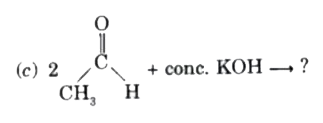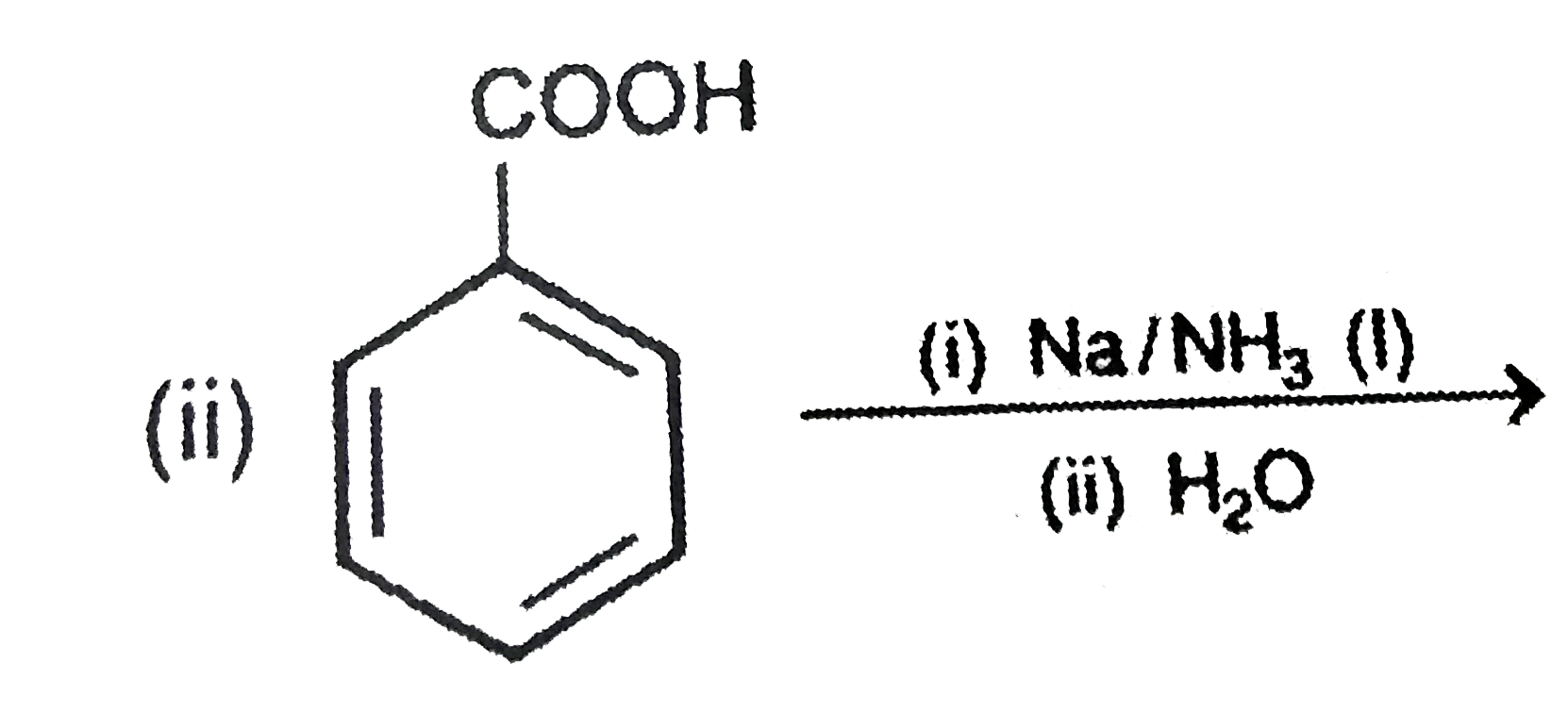Complete the following reaction :
C6H5COCH3(I)NH2NH2−−−−−−−−−−−−−−−−−−−−→(ii)KOH ethylene glycol heat
To complete the reaction given in the question, we will follow the steps outlined in the video transcript. The reaction involves the compound C6H5COCH3 (acetophenone) and proceeds through two main steps: the hydrazone formation and the subsequent reaction with KOH and ethylene glycol.
1. Identify the Reactants:
- The starting compound is acetophenone (C6H5COCH3).
- The reagents used are hydrazine (NH2NH2) for the first step and KOH with ethylene glycol for the second step.
2. Step 1: Formation of Hydrazone:
- In the presence of hydrazine (NH2NH2), the carbonyl group (C=O) of acetophenone undergoes nucleophilic attack by the hydrazine.
- The oxygen of the carbonyl group is partially negative, and the nitrogen of hydrazine is nucleophilic.
- The reaction leads to the formation of a hydrazone intermediate:
C6H5COCH3+NH2NH2→C6H5C(NH2)CH3+H2O
- Here, the carbonyl oxygen is converted to a hydroxyl group, and the nitrogen from hydrazine attaches to the carbon.
3. Step 2: Dehydration and Formation of the Double Bond:
- The hydrazone intermediate is then treated with KOH and ethylene glycol, which acts as a dehydrating agent.
- The base (KOH) abstracts a proton from the nitrogen, leading to the formation of a double bond between the carbon and nitrogen:
C6H5C(NH2)CH3KOH,ethylene glycol−−−−−−−−−−−−→C6H5C=NH+H2O
- This results in the formation of an imine (C6H5C=NH) and water as a by-product.
4. Final Product:
- The final product of the reaction is C6H5C=NH (an imine derived from acetophenone).
Summary of the Reaction:
The overall reaction can be summarized as:
C6H5COCH3+NH2NH2KOH,ethylene glycol−−−−−−−−−−−−→C6H5C=NH+H2O
- The starting compound is acetophenone (C6H5COCH3).
- The reagents used are hydrazine (NH2NH2) for the first step and KOH with ethylene glycol for the second step.
- In the presence of hydrazine (NH2NH2), the carbonyl group (C=O) of acetophenone undergoes nucleophilic attack by the hydrazine.
- The oxygen of the carbonyl group is partially negative, and the nitrogen of hydrazine is nucleophilic.
- The reaction leads to the formation of a hydrazone intermediate:
C6H5COCH3+NH2NH2→C6H5C(NH2)CH3+H2O
- Here, the carbonyl oxygen is converted to a hydroxyl group, and the nitrogen from hydrazine attaches to the carbon.
- The hydrazone intermediate is then treated with KOH and ethylene glycol, which acts as a dehydrating agent.
- The base (KOH) abstracts a proton from the nitrogen, leading to the formation of a double bond between the carbon and nitrogen:
C6H5C(NH2)CH3KOH,ethylene glycol−−−−−−−−−−−−→C6H5C=NH+H2O
- This results in the formation of an imine (C6H5C=NH) and water as a by-product.
- The final product of the reaction is C6H5C=NH (an imine derived from acetophenone).
The overall reaction can be summarized as:
C6H5COCH3+NH2NH2KOH,ethylene glycol−−−−−−−−−−−−→C6H5C=NH+H2O
Topper's Solved these Questions
- BOOK - MODERN PUBLICATIONCHAPTER - ALDEHYDES ,KETONES AND CARBOXYLIC ACIDSEXERCISE - REVISION EXERCISES (OBJECTIVE QUESTIONS - SHORT ANSWER QUESTIONS )36videos
ALDEHYDES ,KETONES AND CARBOXYLIC ACIDS
- BOOK - MODERN PUBLICATIONCHAPTER - ALDEHYDES ,KETONES AND CARBOXYLIC ACIDSEXERCISE - REVISION EXERCISES (OBJECTIVE QUESTIONS - LONG ANSWER QUESTIONS )8videos
ALDEHYDES ,KETONES AND CARBOXYLIC ACIDS
- BOOK - MODERN PUBLICATIONCHAPTER - ALDEHYDES ,KETONES AND CARBOXYLIC ACIDSEXERCISE - REVISION EXERCISES (OBJECTIVE QUESTIONS - ASSERTION REASON QUESTIONS )10videos
ALDEHYDES ,KETONES AND CARBOXYLIC ACIDS
- BOOK - MODERN PUBLICATIONCHAPTER - ALCOHOLS, PHENOLS AND ETHERSEXERCISE - UNIT PRACTICE TEST (FOR BOARD EXAMINATION)12videos
ALCOHOLS, PHENOLS AND ETHERS
- BOOK - MODERN PUBLICATIONCHAPTER - BIOMOLECULESEXERCISE - UNIT PRACTICE TEST FOR BOARD EXAMINATION13videos
BIOMOLECULES
Similar Questions
Knowledge Check
- Question 1 - Select One
Predict the product of the following reaction.
CH3−C∣CH3=O(i)N2N−NH2−−−−−−−−−−−−−→(ii)KOH/Glycol.Δ?ACH3CH2CH3BCH3CHOHCH3CCH3CH2CHODCH3CONHCH3 - Question 2 - Select One
The reaction CH3COCH3(i)NH2−NH2−−−−−−−−−→(ii)KOH,glycolCH3CH2CH3 is known as :
AClemmensen's reductionBBlanc's reductionCBrich reductionDWolff-Kishner reduction - Question 3 - Select One
Identify Z in the following reaction :
2H3CCOCH3i.Ba(OH)2−−−−−−−→ii.Δ,H+ZAH3CCH2CO2HB2H3CCO2HCH3CCOCH2CO2HDH3C−C∣CH3=CHCOCH3
Complete the reaction :
C6H5−NH2+Br2(aq)→View SolutionIdentify the product of the following reactions : (Any two )
(a)CH3−C∣CH3=O(I)H2N−NH2−−−−−−−−−−−→(ii)KOH/glycolΔ ?
(b) C2H5−CO−CH3NaOH/I2−−−−−→?
 View Solution
View SolutionComplete the following reactions :
(i) CH3−CH2−C≡C−CH2−(CH2)6−CH2OH(i)Na/NH3(I)−−−−−−−−−−→(ii)H2O
(ii) View Solution
View SolutionWhat is 'C' in the following reaction ?
C6H5CN+C6H5MgI(i)dry ether−−−−−−−→(ii)H3O+ANH2OH−−−−→BLiAlH4−−−→CView SolutionIn the following reaction sequence, CH3CHOCl2−−−−−→Ca(OH)2XC6H5NH2−−−−−→Alc.KOHY. Y is
View Solution

